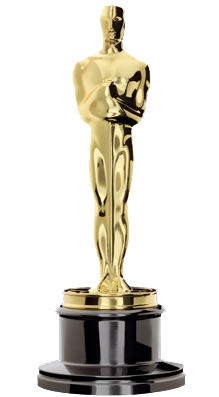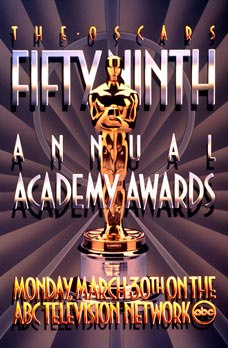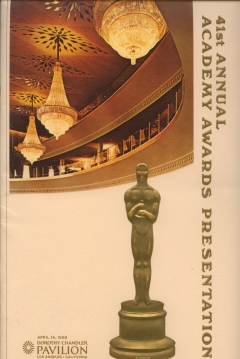
The Academy Awards of Merit, commonly known as the Oscars or Academy Awards, are awards for artistic and technical merit for the film industry. They are presented annually by the Academy of Motion Picture Arts and Sciences (AMPAS) in the United States, in recognition of excellence in cinematic achievements as assessed by the Academy's voting membership. The Oscars are widely considered to be the most prestigious awards in the film industry.
The Academy Award for Best Documentary Feature Film is an award for documentary films. In 1941, the first awards for feature-length documentaries were bestowed as Special Awards to Kukan and Target for Tonight. They have since been bestowed competitively each year, with the exception of 1946. Copies of every winning film are held by the Academy Film Archive.
This is a list of films by year that have received an Academy Award together with the other nominations for best documentary short film. Following the Academy's practice, the year listed for each film is the year of release: the awards are announced and presented early in the following year. Copies of every winning film are held by the Academy Film Archive. Fifteen films are shortlisted before nominations are announced.

The 59th Academy Awards ceremony, organized by the Academy of Motion Picture Arts and Sciences (AMPAS), took place on March 30, 1987, at the Dorothy Chandler Pavilion in Los Angeles beginning at 6:00 p.m. PST / 9:00 p.m. EST. During the ceremony, AMPAS presented Academy Awards in 23 categories honoring films released in 1986. The ceremony, televised in the United States by ABC, was produced by Samuel Goldwyn Jr. and directed by Marty Pasetta. Actors Chevy Chase, Paul Hogan, and Goldie Hawn co-hosted the show. Hawn hosted the gala for the second time, having previously been a co-host of the 48th ceremony held in 1976. Meanwhile, this was Chase and Hogan's first Oscars hosting stint. Eight days earlier, in a ceremony held at The Beverly Hilton in Beverly Hills, California, on March 22, the Academy Awards for Technical Achievement were presented by host Catherine Hicks.

The 41st Academy Awards were presented on April 14, 1969, to honor the films of 1968. They were the first Oscars to be staged at the Dorothy Chandler Pavilion, Los Angeles, and the first with no host since the 11th Academy Awards.
Battle for Life is a nature documentary series made from 1932 until 1934 by Horace Woodard and Stacy Woodard, The short films include the 1935 Oscar award-winning City of Wax, about honey bees. The one-reel short films were released by Educational Pictures. A homemade camera setup for closeups was used. The Woodards followed the series with another series titled Struggle to Live.
Aquatic House Party is a 1950 short film produced by Jack Eaton, part of the Grantland Rice Sportlights series. It won an Oscar for Best Short Subject (One-Reel) at the 22nd Academy Awards in 1949. It featured Helen Morgan.
Van Gogh is a 1948 short French documentary film directed by Alain Resnais. It won an Oscar in 1950 for Best Short Subject (Two-Reel).
Grandad of Races is a 1950 American short documentary film about the Palio di Siena held in the Piazza del Campo in Siena, directed by André de la Varre. It won an Oscar at the 23rd Academy Awards in 1951 for Best Short Subject (One-Reel).

A Time Out of War is a 1954 American short war film directed by Denis Sanders and starring Corey Allen and Barry Atwater. In 1955, it won an Academy Award for Best Short Subject (Two-Reel) at the 27th Academy Awards, first prize at the Venice Film Festival Live Action Short Film category, and a BAFTA Special Award, among others.
Casals Conducts: 1964 is a 1964 American short film directed by Larry Sturhahn. It is a documentary about the cellist and conductor Pablo Casals. It won an Oscar at the 37th Academy Awards in 1965 for Best Short Subject. The Academy Film Archive preserved Casals Conducts: 1964 in 2013.

So Much for So Little is a 1949 American animated short documentary film directed by Chuck Jones and Friz Freleng. In 1950, it won an Oscar at the 22nd Academy Awards for Documentary Short Subject, tying with A Chance to Live. It was created by Warner Bros. Cartoons for the United States Public Health Service. As a work of the United States Government, the film is in the public domain. The Academy Film Archive preserved So Much for So Little in 2005. Produced during the Harry S. Truman administration, it attained renewed relevance during the modern Medicare for All movement in the United States nearly seven decades later.
Why Korea? is a 1950 American short documentary film produced by Edmund Reek at the request of the Secretary of Defense Louis Johnson and used newsreel footage to explain the Korean War. In 1951, it won an Oscar for Documentary Short Subject at the 23rd Academy Awards. The Academy Film Archive preserved Why Korea? in 2005.
The Flight of the Gossamer Condor is a 1978 American short documentary film directed by Ben Shedd, about the development of the Gossamer Condor, the first human-powered aircraft, by a team led by Paul MacCready. The Academy Film Archive preserved The Flight of the Gossamer Condor in 2007.

Marshall Curry is an Oscar-winning American documentary director, producer, cinematographer and editor. His films include Street Fight, Racing Dreams, If a Tree Falls: A Story of the Earth Liberation Front, Point and Shoot, and A Night at the Garden. His first fiction film was the Academy Award-winning short film The Neighbors' Window (2019).
The Titan: Story of Michelangelo is a 1950 German documentary film about the painter and sculptor Michelangelo. It won the Academy Award for Best Documentary Feature.
1848 is a 1949 French short documentary film directed by Marguerite de la Mure and Victoria Mercanton and starring Bernard Blier. The film explains the French Revolution of 1848. Bernard Blier's narration is supported by pictures once drawn by contemporary artists including Honoré Daumier.
The Rising Tide is a 1949 Canadian short documentary film directed by Jean Palardy and produced by the National Film Board of Canada.
The Stairs is a 1950 American short documentary film. It focuses on a woman in her sixties who retires and goes to live with her daughter.
Mitchell Block is an American filmmaker, primarily a producer of documentary films.






